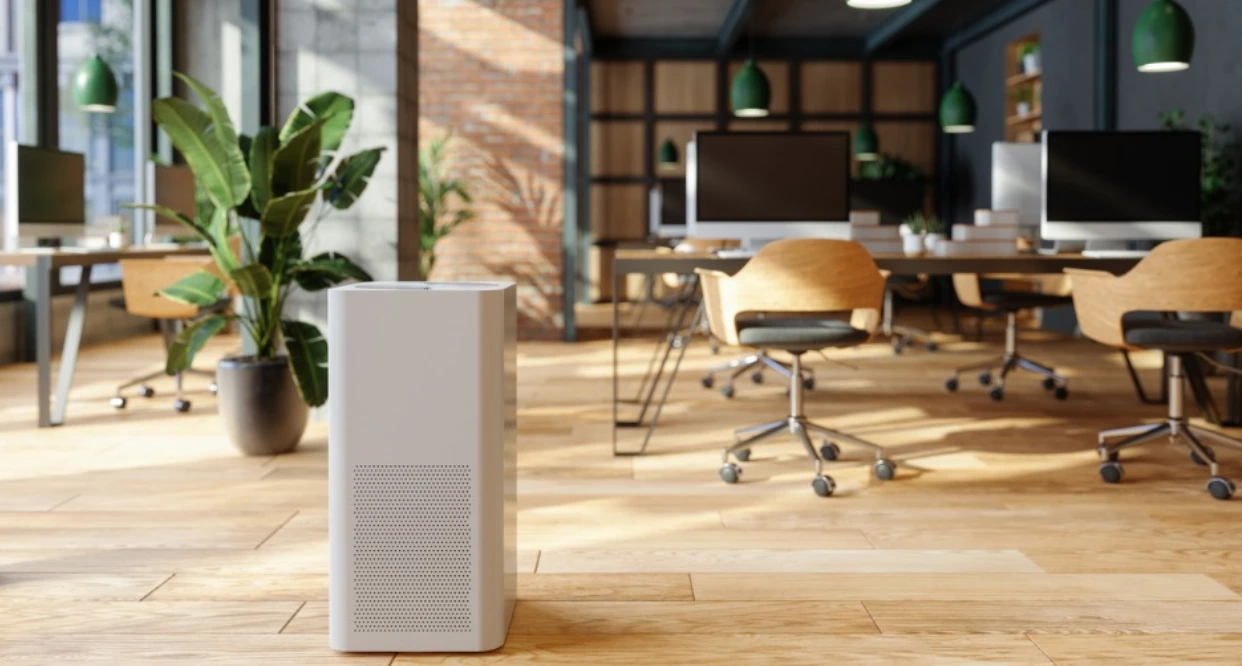What is ventilation and air purification commercial buildings?
Ventilation is necessary for buildings to remove stale air and replace it with fresh air.
This helps to:
- Moderate internal temperatures.
- Reduce the accumulation of moisture, odors, and other gases that can build up during occupied periods.
- Create air movement, which improves the comfort of occupants.
Ventilation Types
- Mechanical ventilation tends to be driven by HVAC systems.
- Natural ventilation is driven by ‘natural’ pressure differences from one part of the building to another.
- Mixed-mode ventilation systems use both mechanical and natural processes. The mechanical and natural components may be used simultaneously, or at different times of day, or in different seasons of the year.
Recommended Ventilation Rates
The ASHRAE 62.1 (“Ventilation and Acceptable Indoor Air Quality in Buildings”) recommends homes receive no less than 0.35 air changes per hour of outdoor air to ensure adequate indoor air.
For other spaces like offices, shops, and schools, the ASHRAE 62.1 standard doesn’t give a fixed number. Instead, airflow rates based on the size of a room, its use (e.g., school, office, sports arena), and the number of people inside are provided.
Future Development in Ventilation
This important field of HVAC has a direct impact on people’s health and productivity. It has the potential for more significant development since some commonly used methods are not always suitable for delivering the IAQ demanded by the building occupants and meeting stricter energy performance guidelines. As awareness of the impact of ventilation on human health and productivity increases, it is expected to become more topical. It is anticipated that more advances in the delivery of fresh air to occupants will be foreseen to meet people’s aspirations. It would be expected, therefore, that:
- More comprehensive application of demand control ventilation (DCV), i.e., a direct link of fresh air supply to IAQ
- More reliance on using simulation tools for visualizing room air movement, such as computational fluid dynamics (CFD), to improve our prediction of the performance of ventilation systems at the design stage
- More advanced algorithms that control BMS systems to regulate ventilation rates dynamically during the day with the improvements on artificial intelligence and IoT devices
- Move toward more energy-efficient methods of room air distribution
- Improvement of the quality assurance and maintenance procedures for ventilation systems by using IoT systems
Covid-19 and Ventilation
Remaining socially distant from each other is a huge part of stopping COVID-19 from spreading, but the risk of an aerosol cross-infection beyond 1.5m from an infected person can also be decreased with a well-designed ventilation system.
Ventilation is a very important way of diluting some of the airborne pathogens that carry the virus. There is strong evidence that demonstrates that occupants of a room are more at risk of catching an illness in a poorly ventilated room than in a well-ventilated room. This is because a poorly ventilated room means that the occupants of the room are exposed to a much higher concentration of airborne pathogens. It is observed that if an influx of people makes CO2 jump from 800 to 1600, the risk of Covid transmission triples. Additionally, the risk for the room occupants will increase with a greater amount of time spent in such an environment.
Air purifiers are just skyrocketing in the market. Gyms, Hospitals, schools, office buildings, firms tend to purchase various types of new air purifiers. The companies selling the devices say they can destroy pathogens and clean the air. Do air purifiers really work? How has it been so trendy?
We believe it is time for neutral, well-informed.
Looking back over the past years and now, there is increasing evidence that air pollution can affect human physical and cognitive development. Not just exposure outside, pollution can also move into buildings through windows, doors, and cracks in buildings. So, closing the doors and windows of our house does not mean we can shut off external pollutants.
Not only that, as the air is not so circulated indoors as outdoors, the problem is the air inside becomes stale and more polluted. Long-standing solutions are needed to ensure that the right to breathe healthy air becomes a reality for all. Plus, when COVID-19 hit, building managers and occupants paid more attention to indoor air quality to avoid another virus spike. One way to purify the air of particulates or gases is through air purifier technologies. These are just a background on why these products are trendy…
When it comes to scientific description, ASHRAE explains air purifiers as “Air cleaners can help remove or inactivate air contaminants. When either is a risk, operate the device(s) continuously.”. Other alternative names are portable, stand-alone, plug-in, or room air cleaners.
An air purifier circulates/refreshes stale air in a room and captures the particles and gases in the filters. Inactivation/removing these several types of pollutants can lead to reducing the chances of health issues caused by indoor pollutants.
Technology Insights
The specific contaminants that are eventually eliminated through an air purifier vary upon the model you select. Unlike the filters that only remove particles, air purification appliances can contain one or more technologies. Air purifiers can also work on the principles of catalysis or photocatalysis, plasma, ozonation or ionization. According to technology air purifiers also destruct indoor contaminants (by photocatalysis, ionization, etc.) or functionalised materials that trap and neutralise pollutants such as formaldehyde or use photocatalysis.
Filtration is one of the technologies involving the trapping of particles in the air using physical and mechanical processes: sieving, inertia, interception, and diffusion. The air purification filters are used chiefly for dust removal. Different types of filters are available, mainly based on the size of the captured particles. The filter is blocked and reduces its function with frequent usage. There is consequently a requirement for regular maintenance, including filter changing. And to keep in mind, they only clean the air that passes through it but will not help much once these contaminants. Such as larger, heavier allergens, such as mites, mold, and pollen, settle to the ground so quickly rest on the furniture and other surfaces.
Another one is the UV-C (ultraviolet light in the germicidal wavelength) that kills or inactivates viruses and microorganisms to make them non-infectious but does not remove them from the air. Technologies such as ionizers, UC-PCO, and many called by the other names may claim to remove or destroy multiple types of contaminants but may convert them to other compounds that might be harmful. They have the risks of emitting by-products, too.
According to ASHRAE and the French National Agency for Food, Environmental and Occupational Health & Safety (ANSES), the effectiveness of some new technologies and data on possible health benefits remains incomplete. Even more than that, indoor air purifiers such as ionizers, UV-C, and many others promise to eliminate or destroy multiple contaminants but may transform them into other harmful compounds. When air purifiers are needed, the research currently considers only mechanical filtration to be “safe.”.
So, do you need one?
Suppose your HVAC equipment is not meeting ventilation and filtration recommendations. In that case, it is necessary to remove contaminants close to the source or where there is a higher risk.
How can you choose which one is right for you?
Factors such as cost, space size and layout, airflow, ventilation and amount of clear air needed have led to the right product in developing a wide variety of air purifiers. Even we start to see air purifiers in the headphones. Dyson revealed its first wearable purifier that captures air pollution and delivers purified air straight to the user’s face.
What is in the air? What do you want to remove?
Before investing money in an air purifier, you might consider conducting an air quality test first to see if you really need one. Innovative sensor technology can be the first step to monitor your indoor air quality and, thus, alert you under harmful circumstances. As a Sensgreen team, we strive to help protect occupancy health, safety, and well-being by providing an innovative system. Our sensor technology allows them to continuously track air quality, identify pollution’s cause, and find perfect solutions.
With an easy-to-use app, accurate and transparent information system, we are here for you to make your world safer, healthier, and more productive!
The most effective approaches to improve your indoor air quality are to minimize or remove polluting sources and to ventilate with clean outdoor air. Furthermore, research indicates that filtration can be a great alternative to source control and ventilation.
IAQ can be improved by using a portable air cleaner and/or the air filter in a central furnace or central heating, ventilation and HVAC system. Portable air cleaners, well known as air purifiers or air sanitizers, are useful for filtering the air in a single. The clean air delivery rate (CADR) which is a metric for delivery of essentially clean air given in cubic feet per minute. Filters for central furnaces and HVAC systems are designed to filter the air throughout a home rather than just in a single space. Minimum Efficiency Reporting Value (MERV) ratings are useful for abstract comparison of products ranging from MERV 1 to MERV 16 based on the average removal efficiency across three particle size ranges.
Two important tips for air filtration are:
- No air cleaner or filter can remove all of the pollutants in air. It is important to note that most filters are designed to filter either particles or gases. As a result, many air cleaners have two filters, one for particles and one for gases or use a lot of adsorbents or chemisorbents medium, to filter both particles and gases.
- All filters must be replaced on a regular basis. If a filter is unclean and overloaded, it will not function properly.


